(完整word版)时间状语从句地引导词
状语从句(9种

1.时间状语从句常用引导词:when, as, while, as soon as, before, after, since , till, until特殊引导词:the minute, the moment, the second, every time, the day,the instant, immediately , directly, no sooner … than, hardly …when, scarcely … whenI didn’t realize how special my mother was until I became an adult.While John was watching TV, his wife was cooking.The children ran away from the orchard(果园), the moment they saw the guard.No sooner had I arrived home ,then it began to rain.Every time I listen to your advice, I get into trouble.2.地点状语从句常用引导词:where特殊引导词:wherever, anywhere, everywhereGenerally, air will be heavily polluted where there are factories.Wherever you go, you should work hard.地点状语从句§4地点状语从句 (adverbial clause of place) 地点状语从句一般由连接副词where, wherever等引导,已经形成了固定的句型,例如:句型1:Where+地点从句,(there)+主句。
【注意】此句型通常译成“哪里……哪里就……”;主句在从句后面时,there可用可不用;如果主句在从句的前面时,一般都不用there。
引导时间状语从句的五类引导词
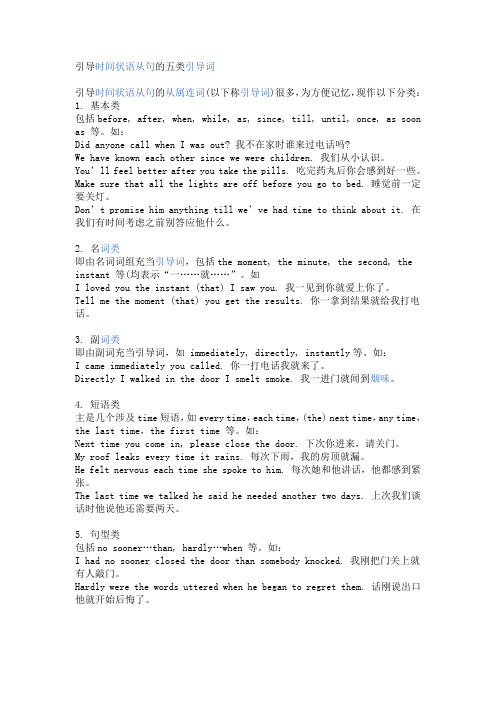
引导时间状语从句的五类引导词引导时间状语从句的从属连词(以下称引导词)很多,为方便记忆,现作以下分类:1. 基本类包括before, after, when, while, as, since, till, until, once, as soon as 等。
如:Did anyone call when I was out? 我不在家时谁来过电话吗?We have known each other since we were children. 我们从小认识。
You’ll feel better after you take the pills. 吃完药丸后你会感到好一些。
Make sure that all the lights are off before you go to bed. 睡觉前一定要关灯。
Don’t promise him anything till we’ve had time to think about it. 在我们有时间考虑之前别答应他什么。
2. 名词类即由名词词组充当引导词,包括the moment, the minute, the second, the instant 等(均表示“一……就……”。
如I loved you the instant (that) I saw you. 我一见到你就爱上你了。
Tell me the moment (that) you get the results. 你一拿到结果就给我打电话。
3. 副词类即由副词充当引导词,如 immediately, directly, instantly等。
如:I came immediately you called. 你一打电话我就来了。
Directly I walked in the door I smelt smoke. 我一进门就闻到烟味。
4. 短语类主是几个涉及time短语,如every time,each time,(the) next time,any time,the last time,the first time 等。
时间状语从句(完整版)
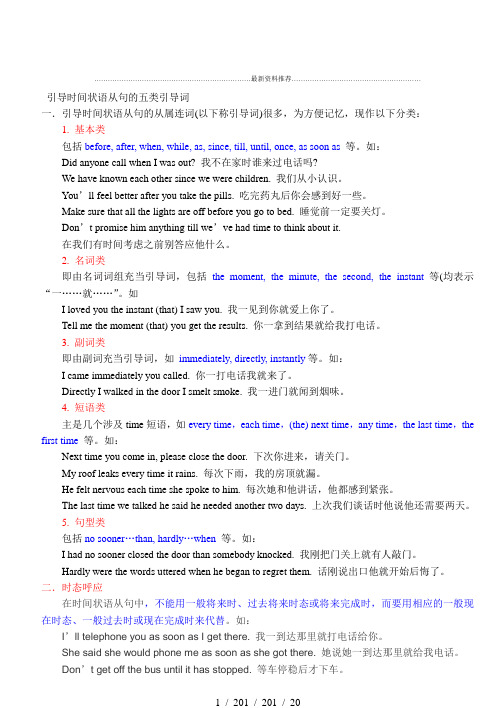
……………………………………………………………最新资料推荐…………………………………………………引导时间状语从句的五类引导词一.引导时间状语从句的从属连词(以下称引导词)很多,为方便记忆,现作以下分类:1. 基本类包括before, after, when, while, as, since, till, until, once, as soon as 等。
如:Did anyone call when I was out? 我不在家时谁来过电话吗?We have known each other since we were children. 我们从小认识。
You’ll feel better after you take the pills. 吃完药丸后你会感到好一些。
Make sure that all the lights are off before you go to bed. 睡觉前一定要关灯。
Don’t promise him anything till we’ve had time to think about it.在我们有时间考虑之前别答应他什么。
2. 名词类即由名词词组充当引导词,包括the moment, the minute, the second, the instant 等(均表示“一……就……”。
如I loved you the instant (that) I saw you. 我一见到你就爱上你了。
Tell me the moment (that) you get the results. 你一拿到结果就给我打电话。
3. 副词类即由副词充当引导词,如immediately, directly, instantly等。
如:I came immediately you called. 你一打电话我就来了。
Directly I walked in the door I smelt smoke. 我一进门就闻到烟味。
状语从句中时间状语从句的引导词与用法
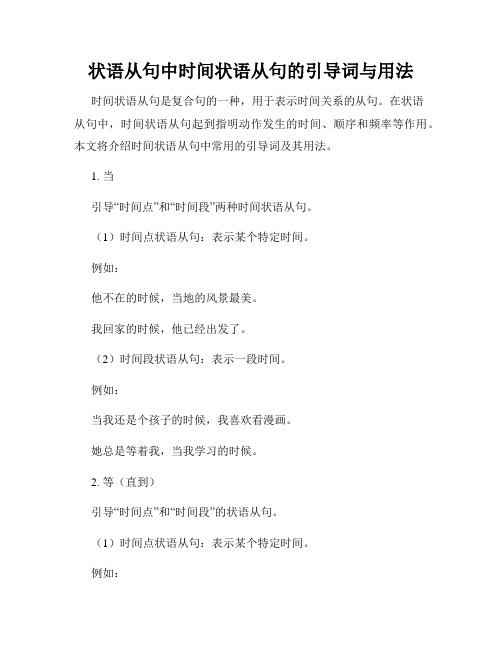
状语从句中时间状语从句的引导词与用法时间状语从句是复合句的一种,用于表示时间关系的从句。
在状语从句中,时间状语从句起到指明动作发生的时间、顺序和频率等作用。
本文将介绍时间状语从句中常用的引导词及其用法。
1. 当引导“时间点”和“时间段”两种时间状语从句。
(1)时间点状语从句:表示某个特定时间。
例如:他不在的时候,当地的风景最美。
我回家的时候,他已经出发了。
(2)时间段状语从句:表示一段时间。
例如:当我还是个孩子的时候,我喜欢看漫画。
她总是等着我,当我学习的时候。
2. 等(直到)引导“时间点”和“时间段”的状语从句。
(1)时间点状语从句:表示某个特定时间。
例如:等我回到家,他已经做好了晚餐。
等天黑了再出发吧。
(2)时间段状语从句:表示一段时间。
例如:等我睡醒了再去吃早饭。
等我们碰面的时候,他已经等了一个小时了。
3. 一…就…表示动作发生的非常迅速,强调前后两个动作的时间顺序。
例如:一看见他,我就明白了事情的真相。
一听到他的声音,我就感到撕心裂肺的痛。
4. 每当(每次)表示动作的反复发生。
例如:每当我看到这张照片,就会想起我们在一起的美好时光。
每次他来这个城市,我们都会一起聚会。
5. 每逢(逢…就…)表示动作在某个情况下反复发生。
例如:每逢下雨,她就害怕。
逢年过节,我们就会回家团聚。
6. 每表示动作的频率,相当于“每隔”。
例如:每两天他就去一次健身房。
每年这个时候,我们都会举行一次家庭聚会。
7. 每隔表示动作的时间间隔。
例如:每隔一小时,我就会休息一下。
每隔一周,我们就有一次团队会议。
8. 一旦表示一旦某个条件实现,就会发生某个动作。
例如:一旦暴风雨来临,我们就要开始撤离。
一旦他迟到了,就会被罚款。
9. 每天表示每天都发生的动作。
例如:每天早上起床后,我都会去散步。
每天晚上,他都会给我打电话。
10. 每次表示每次都发生的动作。
例如:每次上课的时候,老师都会检查我们的作业。
每次去超市,我都会买一些水果。
九大状语从句引导词总结
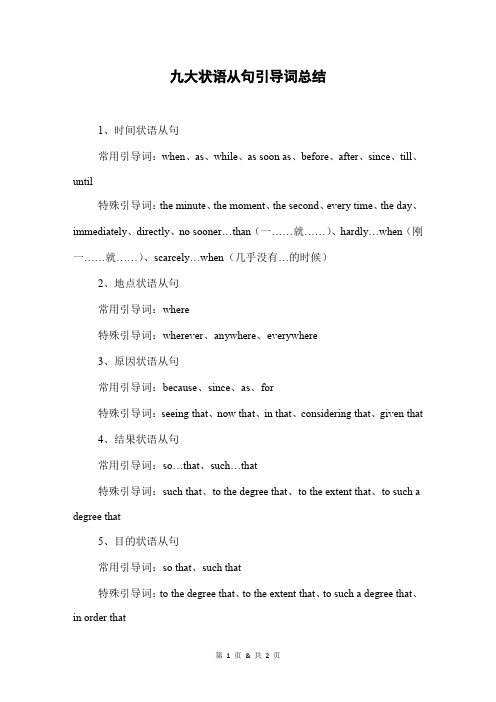
九大状语从句引导词总结
1、时间状语从句
常用引导词:when、as、while、as soon as、before、after、since、till、until
特殊引导词:the minute、the moment、the second、every time、the day、immediately、directly、no sooner…than(一……就……)、hardly…when(刚一……就……)、scarcely…when(几乎没有…的时候)
2、地点状语从句
常用引导词:where
特殊引导词:wherever、anywhere、everywhere
3、原因状语从句
常用引导词:because、since、as、for
特殊引导词:seeing that、now that、in that、considering that、given that
4、结果状语从句
常用引导词:so…that、such…that
特殊引导词:such that、to the degree that、to the extent that、to such a degree that
5、目的状语从句
常用引导词:so that、such that
特殊引导词:to the degree that、to the extent that、to such a degree that、in order that
第 1 页& 共 2 页。
状语从句(9种全)
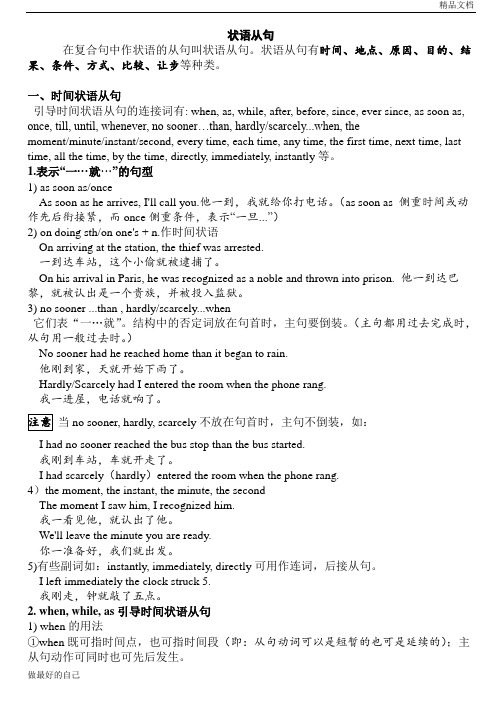
状语从句在复合句中作状语的从句叫状语从句。
状语从句有时间、地点、原因、目的、结果、条件、方式、比较、让步等种类。
一、时间状语从句引导时间状语从句的连接词有: when, as, while, after, before, since, ever since, as soon as, once, till, until, whenever, no sooner…than, hardly/scarcely...when, themoment/minute/instant/second, every time, each time, any time, the first time, next time, last time, all the time, by the time, directly, immediately, instantly等。
1.表示“一···就···”的句型1) as soon as/onceAs soon as he arrives, I'll call you.他一到,我就给你打电话。
(as soon as 侧重时间或动作先后衔接紧,而once侧重条件,表示“一旦...”)2) on doing sth/on one's + n.作时间状语On arriving at the station, the thief was arrested.一到达车站,这个小偷就被逮捕了。
On his arrival in Paris, he was recognized as a noble and thrown into prison. 他一到达巴黎,就被认出是一个贵族,并被投入监狱。
3) no sooner ...than , hardly/scarcely...when它们表“一…就”。
结构中的否定词放在句首时,主句要倒装。
状语从句(9种全)
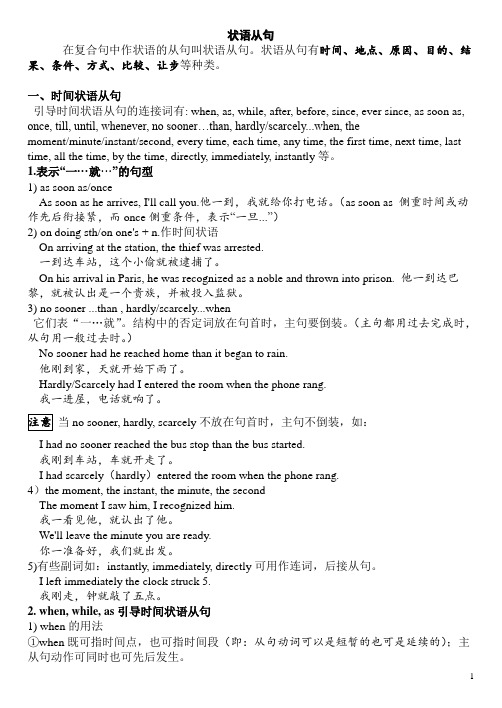
状语从句在复合句中作状语的从句叫状语从句。
状语从句有时间、地点、原因、目的、结果、条件、方式、比较、让步等种类。
一、时间状语从句引导时间状语从句的连接词有: when, as, while, after, before, since, ever since, as soon as, once, till, until, whenever, no sooner…than, hardly/scarcely...when, themoment/minute/instant/second, every time, each time, any time, the first time, next time, last time, all the time, by the time, directly, immediately, instantly等。
1.表示“一···就···”的句型1) as soon as/onceAs soon as he arrives, I'll call you.他一到,我就给你打电话。
(as soon as 侧重时间或动作先后衔接紧,而once侧重条件,表示“一旦...”)2) on doing sth/on one's + n.作时间状语On arriving at the station, the thief was arrested.一到达车站,这个小偷就被逮捕了。
On his arrival in Paris, he was recognized as a noble and thrown into prison. 他一到达巴黎,就被认出是一个贵族,并被投入监狱。
3) no sooner ...than , hardly/scarcely...when它们表“一…就”。
结构中的否定词放在句首时,主句要倒装。
9大状语从句的引导词

九大状语从句的引导词时间状语从句:when(当…..时候), while(当….时候) ,as(当..时候,一边), after(在….之后), before(在…..之前), since(自从), ever since(自从)till/until(直到),not….until(直到..才),as soon as(一...就),whenever(不管什么时候),every time(每次),each time(每次)next time(下次),the first time(第一次)any time(任何) the moment(一...就...)by the time(到...), directly(一..就...), immediately(一...就..), instantly(一...就..), as long as(长达), hardly/scarcely… when….(一..就..)once(一..就..)no sooner… than….(一...就..)地点状语从句: where, wherever=no matter where(无论哪里)原因状语从句:because(因为), as(因为), since(自..以来), for(因为),for the reason that(因为),considering that, due to the fact that, owing to the fact that, in that(因为), seeing that(因为),considering that/since (既然)等条件状语从句: if(如果), unless(除非), as(so) long as(只要),in case(万一) on condition that(条件是) supposing(假设),provided that(如果) ,as far as /so far as(就…而言),even though, even if (即使), providing(that),方式状语从句:as(正如), just as(就好像,正如), as if(好像), as though(好像)让步状语从句: although(尽管), though(尽管), even if(即使), even though(即使), as, whether…or….(无论....),no matter what /when/how(无论什么,何时,怎样),now that(既然), despite(尽管),in spite of目的状语从句:that, so that(如此...以此于), in order that(为了), lest(唯恐)in case(唯恐),结果状语从句: so that, so….that, such…that(如此…….以至于)比较状语从句:as….as(和...一样), not so…..as(not as…..as)(不如...), more…than(多于)less….than, the+比较级…. ,The+比较级…..1994-2008高考英语真题状语从句总汇1. — How long has this bookshop been in business? ____________ 1982. ( 94 )A. AfterB. InC. FromD. Since2. Mother was worried because little Alice was ill, especially ______Father was away in France. ( 94 )A. asB. thatC. duringD. if3. If we work with a strong will, we can overcome any difficulty, __________ great it is. ( 95 )A. whatB. howC. howeverD. whatever4. After the war, a new school building was put up _____________ there had once been a theatre. ( 97 )A. thatB. whereC. whichD. when5. — I am going to the post office. _______you’re there, can you get me some stamps? ( 99 )A. AsB. WhileC. BecauseD. If6. You should make it a rule to leave things _____________ you can find them again. ( 99 )A. whenB. whereC. thenD. there7. ____________ you’ve got the chance, you might as well make full use of it. ( 99 )A. Now thatB. AfterC. AlthoughD. As soon as8. We’ll have to finish the job, _____________. ( 99 )A. long it takes howeverB. it takes however longC. long however it takesD. however long it takes9. Someone called me up in the middle of the night, but they hung up ____________ I could answer the phone. ( 00 ) A. as B. since C. until D. before10. The WTO cannot live up to its name _____________ it does not include a country that is home to onefifth of mankind. ( 00 )A. as long asB. whileC. ifD. even though11. The men will have to wait all day ____________ the doctor works faster. ( 01春季)A. ifB. unlessC. whetherD. that12. — Did you remember to give Mary the money you owed her? — Yes, I gave it to her _____ I saw her.( 01春季)A. whileB. the momentC. suddenlyD. once13. Americans eat _____________ vegetables per person today as they did in 1910. (02上海春季)A. more than twiceB. as twice as manyC. twice as many asD. more than twice as many14. — How far apart do they live? _____I know, they live in the same neighbourhood. ( 03上海)A. As long asB. As well asC. As far asD. As often as15. A good storyteller must be able to hold his listeners’ curiosity ______ he reaches the end of the story.A. whenB. unlessC. afterD. until ( 03上海)16. Generally speaking, ____________ according to the directions, the drug has no side effect. ( 03上海)A. when takingB. when takenC. when to takeD. when to be taken17. —Dad, I’ve finished my assignment.—Good, and _____ you play or watch TV, you mustn’t disturb me. ( 03上海)A. wheneverB. whetherC. whateverD. no matter18. — Was his father very strict with him when he was at school?— Yes. He has never praised him _______ he became one of the top students in his grade. (03 北京春季)A. afterB. unlessC. untilD. when19. He made a mistake, but then he corrected the situation ____________ it got worse. (03 北京)A. untilB. whenC. beforeD. as20. _____________ I know the money is safe, I shall not worry about it. (03 北京)A. Even thoughB. UnlessC. WhileD. As long as21. Scientists say it may be five or six years ________ it is possible to test this medicine on human patients.A. sinceB. afterC. beforeD. when ( 04 福建)22. You should try to get a good night’s sleep __________ much work you have to do . ( 04 湖北)A. howeverB. no matterC. althoughD. whatever23. It was evening ________ we reached the little town of Winchester .A. thatB. untilC. sinceD. before24. _____ modeling business is by no means easy to get into, the good model will always be in demand.A. WhileB. SinceC. AsD. If( 04 浙江)25. We were swimming in the lake _______ suddenly the storm started. ( 04 北京春季)A. whenB. whileC. untilD. before26. _______ I can see, there is only one possible way to keep away from the danger. ( 04 北京春季)A. As long asB. As far asC. Just asD. Even if27. We were told that we should follow the main road ________ we reached the central railway station .( 04 辽宁) A. whenever B. until C. while D. wherever28. _____ you call me to say you' re not coming, I'll see you at the theatre. ( 04 四川)A. ThoughB. WhetherC. UntilD. Unless29. You can eat food free in my restaurant ________ you like. ( 04 重庆)A. wheneverB. whereverC. whateverD. however30. _____________ I accept that he is not perfect, I do actually like the person. ( 04 江苏)A. WhileB. SinceC. BeforeD. Unless31. Several weeks had gone by ______I realized the painting, was missing. ( 04 )A. asB. beforeC. sinceD. when32. Jasmine was holidaying with her family in a wildlife park _____ she was bitten on the leg by al lion.( 04 上海) A. when B. while C. since D. once33. ________, I have to put it away and focus my attention on study this week. ( 04上海春季)A. However the story is amusing B No matter amusing the story isC. However amusing the story isD. No matter how the story is amusing34. It is almost five years we saw each other last time.A. beforeB. sinceC. afterD. when35. What a table ! I’ve never seen such a thing before .It is it is long. ( 05 湖北)A. half not as wide asB. wide not as half asC. not half as wide asD. as wide as not half36. Simon thought his computer was broken his little brother pointed out that he had forgotten to turn it on. ( 05 北京春季) A. until B. unless C. after D. because37. I’d like to arrive 20 minutes early _______ I can have time for a cup of tea. ( 05 北京)A. as soon asB. as a resultC. in caseD. so that38. It wasn’t until nearly a month later I received the manager’s reply. ( 05河南、河北)A. sinceB. whenC. asD. that39. Unlike watching TV, reading is a highly active process (过程)________ it requires attention as well asmemory and imagination. (05 江苏)A. untilB. butC. unlessD. for40. The old tower must be saved, _____________ the cost. ( 05 浙江)A. howeverB. whateverC. whicheverD. wherever41. You must keep on working in the evening ______ you are sure you can finish the task in time. ( 05 安徽)A. asB. ifC. whenD. unless42. That was really a splendid evening. It' s years _______ I enjoyed myself so much. ( 05 安徽)A. whenB. thatC. beforeD. since43. John is the tallest boy in the class, ___________ according to himself. ( 05 安徽)A. five foot eight as tall asB. as tall as five foot eightC. as five foot eight tall asD. as tall five foot eight as44. —Did Jack come back early last night?—Yes. I t was not yet eight o’clock he arrived home. ( 05 福建)A. beforeB. whenC. thatD. until45. Allow children the space to voice their opinions, __________ they are different from your own. ( 05 湖南) A. until B. even if C. unless D. as though46. The more I think about him, the more reasons I find for loving him ___ I did. ( 05 湖南)A. as much asB. as long asC. as soon asD. as far as47. you’ve tried it. you can’t imagine how pleasant it is. (06北京)A. UnlessB. BecauseC. AlthoughD. When48. --- How long do you think it will be _________ China sends a manned spaceship to the moon?--- Perhaps two or three years. (06福建)A. whenB. untilC. thatD. before49. Jenny was very sad over the loss of the photos she had shot at Canada, this was a memory she especially treasured. (06广东)A. asB. ifC. whenD. where50. "You can't have this football back you promise not to kick it at my cat again," the old man said firmly. (06广东) A. because B. since C. when D. until51. I had just stepped out of the bathroom and was busily drying myself with a towel ____ I heard the steps. (06湖南) A. while B. when C. since D. after52. _________ environmental damage is done, it takes many years for the ecosystem (生态系统) to recover. (06江苏) A. Even if B. If only C. While D. Once53. He was about halfway through his meal a familiar voice came to his ears. (06辽宁)A. whyB. whereC. whenD. while54. he has limited technical knowledge, the old worker has a lot of experience. (06全国I )A. SinceB. UnlessC. AsD. Although55. We’re just trying to teach a point ____ both sides will sit down together and talk. (06 山东)A. whereB. thatC. whenD. which56. How can you expect to learn anything ____ you never listen? (06山东)A. in caseB. even ifC. unlessD. when57. His plan was such a good one _________we all agreed to accept it. (06 陕西)A. soB. andC. thatD. as58. This is a very interesting book. I’ll buy it, __________. (06 陕西)A. how much may it costB. no matter how it may costC. however much it may costD. how may it cost59. My parents were quarrelling about me ____ I could not quite tell why. (06上海)A. sinceB. thoughC. ifD. until60. --- Mom, what did your doctor say? --- He advised me to live the air is fresher. (06四川)A. in whereB. in whichC. the place whereD. where61. --- Why didn’t you tell him about the meeting?--- He rushed out of the room I could say a word. (06四川)A. beforeB. untilC. whenD. after62. The cost of living in Glasgow is among the lowest in Britain, the quality of life is probably one of thehighest. (06天津) A. since B. when C. as D. while63. If you are traveling the customs are really foreign to your own, please do as the Romans do. (06天津) A. in which B. what C. when D. where64. In time of serious accidents,_________ we know some basic things about first aid, we can save lives.(06重庆) A. whether B. until C. if D. unless65. ____ most of the earth’s surface is covered by water, fresh water is very rare and precious. (06上海春季)A. AsB. OnceC. IfD. Although66 .He was told that it would be at least three more months he could recover and return work. 2007江西A. whenB. beforeC. sinceD. that67. The field research will take Joan and Paul about five months; it will be a long time _____ we meet themagain.2007安徽 A. after B. before C. since D. when68 In my opinion, life in the twenty-first century is much easier than ________.2007安徽A. that used to beB. it is used toC. it was used toD. it used to be69. Most birds find it safe to sleep in the trees, but ________ they have eggs or young chicks, they don’t use a nest.2007湖南 A. why B. how C. unless D. where70. Pop music is such an important part of society ______ it has even influenced our language. 2007上海A. asB. thatC. whichD. where71. Many of them turned a deaf ear to his advice, _______ they knew it to be valuable 2007浙江.A. as ifB. now thatC. even thoughD. so that72. My parents live in a small village. They always keep candles in the house _____ there is a power out.A. ifB. unlessC. in caseD. so that 2007重庆73. I won’t call you, ________ something unexpected happens. 2007 海南A. unlessB. whetherC. becauseD. while74.________I really don’t like art, I find his work impressive. 2007山东A.As B.Since C.If D.While75. Leave your key with a neighbor ___ you lock yourself out one day2007北京A. ever sinceB. even ifC. soon afterD. in case76. We had to wait half an hour ______ we had already booked a table (2007辽宁.)A. sinceB. althoughC. untilD. before77. Small sailboats can easily turn over in the water ______ they are not managed carefully.A. thoughB. beforeC. untilD. if 2007上海78. Having checked the doors were closed , and _________ all the lights were off, the boy opened the door to hisbedroom. 2007湖南A. whyB. thatC. whenD. where79.---Where’s that report?---I brought it to you ____you were in Mr. Black’s office yesterday. 2007北京A. ifB. whenC. becauseD. before80___ he had not hurt his leg, John would have won the race. 2007 国2A. IfB. SinceC. ThoughD. When81. All people, they are old or young, rich or poor, have been trying their best to help those in need sincethe disaster. (2008重庆)A. even ifB. whetherC. no matterD. however82. You'd better not leave the medicine ______ kids can get at it. (2008山东)A. even ifB. whichC. whereD. so that83. I used to love that film ______ I was a child, but I don't feel it that way any more. (2008辽宁卷)A. onceB. whenC. sinceD. although84. Later in this chapter cases will be introduced to readers __ consumer complaints have resulted in changes inthe law. (2008江西卷) A. where B. when C. who D. which85. -----Have you got any particular plans for the coming holiday?----- Yes, _______, I’m going to visit some homes for the old in the city. (2008安徽卷)A. If everB. If busyC. If anythingD. If possible。
状语从句(9种全)
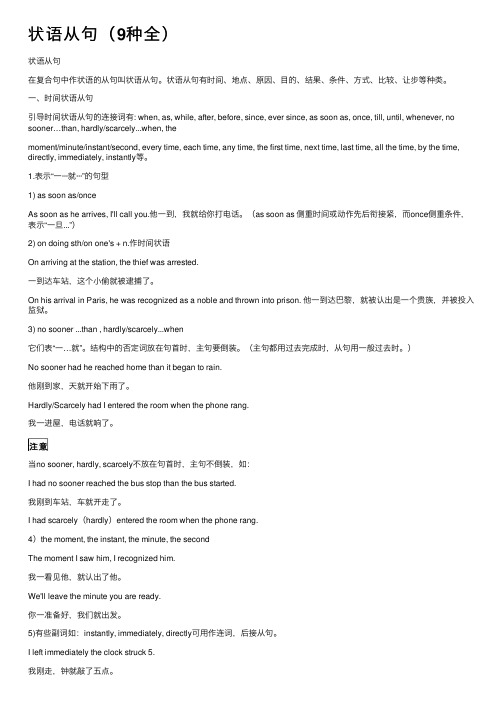
状语从句(9种全)状语从句在复合句中作状语的从句叫状语从句。
状语从句有时间、地点、原因、⽬的、结果、条件、⽅式、⽐较、让步等种类。
⼀、时间状语从句引导时间状语从句的连接词有: when, as, while, after, before, since, ever since, as soon as, once, till, until, whenever, no sooner…than, hardly/scarcely...when, themoment/minute/instant/second, every time, each time, any time, the first time, next time, last time, all the time, by the time, directly, immediately, instantly等。
1.表⽰“⼀···就···”的句型1) as soon as/onceAs soon as he arrives, I'll call you.他⼀到,我就给你打电话。
(as soon as 侧重时间或动作先后衔接紧,⽽once侧重条件,表⽰“⼀旦...”)2) on doing sth/on one's + n.作时间状语On arriving at the station, the thief was arrested.⼀到达车站,这个⼩偷就被逮捕了。
On his arrival in Paris, he was recognized as a noble and thrown into prison. 他⼀到达巴黎,就被认出是⼀个贵族,并被投⼊监狱。
3) no sooner ...than , hardly/scarcely...when它们表“⼀…就”。
结构中的否定词放在句⾸时,主句要倒装。
时间状语从句(完整版)

……………………………………………………………最新资料推荐…………………………………………………引导时间状语从句的五类引导词一.引导时间状语从句的从属连词(以下称引导词)很多,为方便记忆,现作以下分类:1. 基本类包括before, after, when, while, as, since, till, until, once, as soon as 等。
如:Did anyone call when I was out? 我不在家时谁来过电话吗?We have known each other since we were children. 我们从小认识。
You’ll feel better after you take the pills. 吃完药丸后你会感到好一些。
Make sure that all the lights are off before you go to bed. 睡觉前一定要关灯。
Don’t promise him anything till we’ve had time to think about it.在我们有时间考虑之前别答应他什么。
2. 名词类即由名词词组充当引导词,包括the moment, the minute, the second, the instant 等(均表示“一……就……”。
如I loved you the instant (that) I saw you. 我一见到你就爱上你了。
Tell me the moment (that) you get the results. 你一拿到结果就给我打电话。
3. 副词类即由副词充当引导词,如immediately, directly, instantly等。
如:I came immediately you called. 你一打电话我就来了。
Directly I walked in the door I smelt smoke. 我一进门就闻到烟味。
状语从句(9种全)
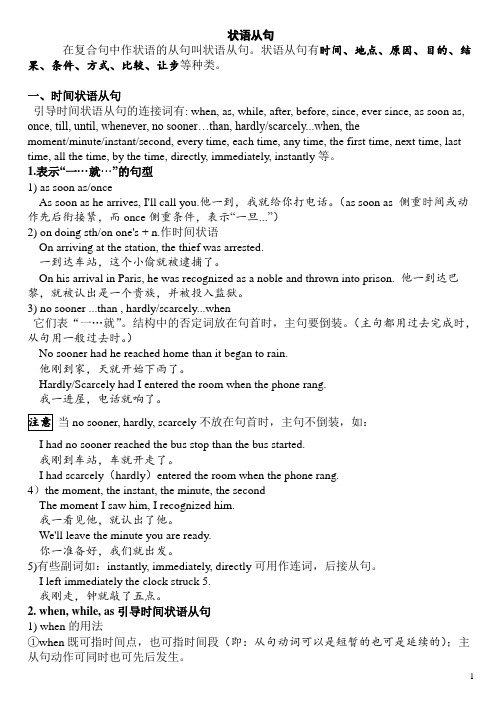
状语从句在复合句中作状语的从句叫状语从句。
状语从句有时间、地点、原因、目的、结果、条件、方式、比较、让步等种类。
一、时间状语从句引导时间状语从句的连接词有: when, as, while, after, before, since, ever since, as soon as, once, till, until, whenever, no sooner…than, hardly/scarcely...when, themoment/minute/instant/second, every time, each time, any time, the first time, next time, last time, all the time, by the time, directly, immediately, instantly等。
1.表示“一···就···”的句型1) as soon as/onceAs soon as he arrives, I'll call you.他一到,我就给你打电话。
(as soon as 侧重时间或动作先后衔接紧,而once侧重条件,表示“一旦...”)2) on doing sth/on one's + n.作时间状语On arriving at the station, the thief was arrested.一到达车站,这个小偷就被逮捕了。
On his arrival in Paris, he was recognized as a noble and thrown into prison. 他一到达巴黎,就被认出是一个贵族,并被投入监狱。
3) no sooner ...than , hardly/scarcely...when它们表“一…就”。
结构中的否定词放在句首时,主句要倒装。
状语从句(9种全)

状语从句在复合句中作状语的从句叫状语从句。
状语从句有时间、地点、原因、目的、结果、条件、方式、比较、让步等种类。
一、时间状语从句引导时间状语从句的连接词有: when, as, while, after, before, since, ever since, as soon as, once, till, until, whenever, no sooner…than, hardly/scarcely...when, themoment/minute/instant/second, every time, each time, any time, the first time, next time, last time, all the time, by the time, directly, immediately, instantly等。
1.表示“一···就···”的句型1) as soon as/onceAs soon as he arrives, I'll call you.他一到,我就给你打电话。
(as soon as 侧重时间或动作先后衔接紧,而once侧重条件,表示“一旦...”)2) on doing sth/on one's + n.作时间状语On arriving at the station, the thief was arrested.一到达车站,这个小偷就被逮捕了。
On his arrival in Paris, he was recognized as a noble and thrown into prison. 他一到达巴黎,就被认出是一个贵族,并被投入监狱。
3) no sooner ...than , hardly/scarcely...when它们表“一…就”。
结构中的否定词放在句首时,主句要倒装。
状语从句的引导词和语序

状语从句的引导词和语序状语从句是英语语法中的重要部分,它可以提供额外的信息来描述、限制或修饰主句。
在使用状语从句时,我们需要熟悉引导词的用法及正确的语序。
本文将介绍状语从句的引导词和语序,帮助读者更好地理解和运用。
一、引导词的种类及用法状语从句的引导词可以分为时间、地点、原因、条件、目的、结果和方式等几类。
下面将逐一介绍各类引导词的用法。
1. 时间状语从句:引导词包括when(当...时)、while(当...的时候)、as(当...的时候)、after(在...之后)、before(在...之前)、since(自从...以来)、until(直到...时候)等。
例如:- I will call you when I arrive. (我到了就会给你打电话。
)- Peter likes to listen to music while he is jogging. (Peter在慢跑时喜欢听音乐。
)- As she grew older, her hair became gray. (随着年龄的增长,她的头发变灰了。
)2. 地点状语从句:引导词包括where(在...的地方)、wherever(无论在哪里)、anywhere(任何地方)、everywhere(每个地方)等。
例如:- I will meet you where the fountain is. (我会在喷泉那里见你。
)- You can go wherever you want. (你可以去任何你想去的地方。
)- The earthquake caused destruction everywhere. (地震造成了到处的破坏。
)3. 原因状语从句:引导词包括because(因为)、since(由于)、as (因为)、being that(由于)等。
例如:- He didn't go to work today because he was sick. (他今天没去上班,因为他生病了。
(word完整版)状语从句(完整归纳),推荐文档

状语从句一.分类:when (当……的时候) while (在……期间) as (当……的时候, 一边……一边……)before (在……之前) since (自从……以来) till/until (直到) hardly…when… (刚……就) as soon as (一……就……)after (在……之后) not…till/until(直到……才)no sooner…than…(刚……就)地点状语从句:where (在那里) wherever(无论哪里)原因状语从句:because (因为) since (因为,既然) as (由于) for (为了) now that(既然)目的状语从句:(so)that=in order that(以便)so as (not)to (以便[不])in case(以免)lest(以免)结果状语从句:so+adj./adv.+that(如此……以致)so that(结果……)such+n.+that(如果……以致)that(所以,因此)让步状语从句:though/although不可同but连用。
though/although (虽然)however (可是)even though(即使)even if (即使)no matter+what/which/where/who/when =whatever/whichever/wherever/whoever/whenever(不论什么/哪一个/哪里/谁/何时)比较状语从句:as (正如)as…as(和……一样)not as/so … as (不如……)than(比……更)the+比较级…+the+比较级(越……越……)条件状语从句:if(假设)unless(如果不)so long as(只要)on condition that (如果)方式状语从句:as(像……那样地)just as(正像)as if(好像)as though(好像)二.各种状语从句的简化方法:1例:After she sang,she left the rich man's house.= After singing,she left the rich man's house.2.以as soon as引导的状语从句的主语若与主句主语一致时,从句等于on+doing sth.,作状语,此时的动词为非延续性动词。
(完整版)时间状语从句的引导词
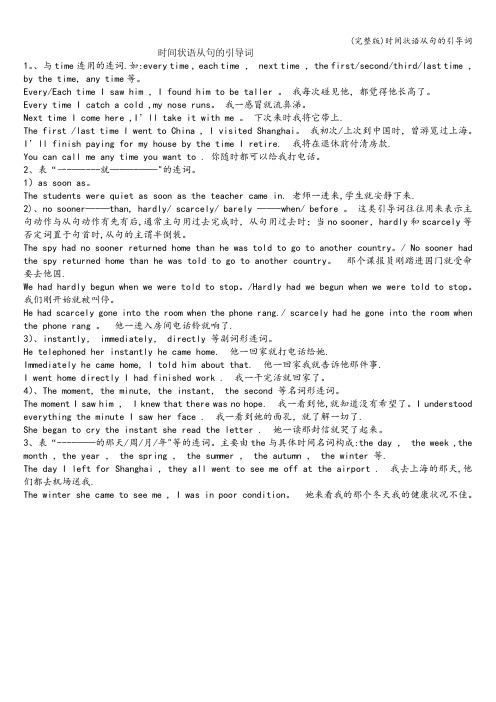
(完整版)时间状语从句的引导词时间状语从句的引导词1。
、与time连用的连词.如:every time , each time , next time ,the first/second/third/last time ,by the time, any time等。
Every/Each time I saw him ,I found him to be taller 。
我每次碰见他,都觉得他长高了。
Every time I catch a cold ,my nose runs。
我一感冒就流鼻涕。
Next time I come here ,I’ll take it with me 。
下次来时我将它带上.The first /last time I went to China , I visited Shanghai。
我初次/上次到中国时,曾游览过上海。
I’ll finish paying for my house by the time I retire. 我将在退休前付清房款.You can call me any time you want to . 你随时都可以给我打电话。
2、表“一-—----就—-—-——"的连词。
1)as soon as。
The students were quiet as soon as the teacher came in. 老师一进来,学生就安静下来.2)、no sooner—-—than, hardly/ scarcely/ barely ——-when/ before 。
这类引导词往往用来表示主句动作与从句动作有先有后,通常主句用过去完成时,从句用过去时;当no sooner,hardly和scarcely等否定词置于句首时,从句的主谓半倒装。
The spy had no sooner returned home than he was told to go to another country。
9大状语从句的引导词
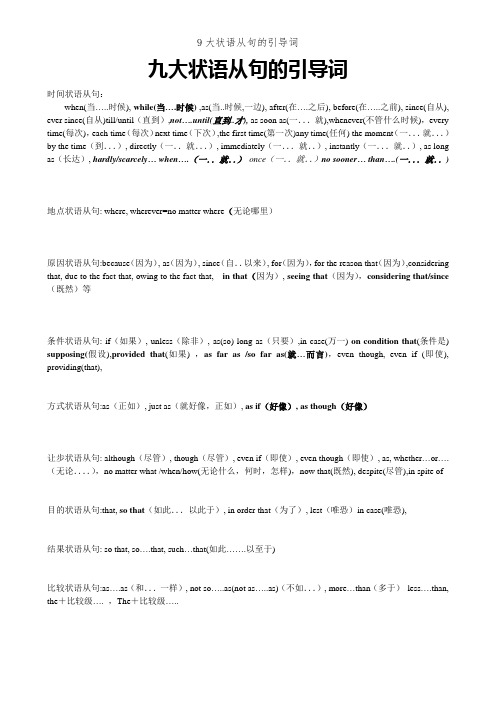
九大状语从句的引导词时间状语从句:when(当…..时候), while(当….时候) ,as(当..时候,一边), after(在….之后), before(在…..之前), since(自从), ever since(自从)till/until(直到),not….until(直到..才),as soon as(一...就),whenever(不管什么时候),every time(每次),each time(每次)next time(下次),the first time(第一次)any time(任何) the moment(一...就...)by the time(到...), directly(一..就...), immediately(一...就..), instantly(一...就..), as long as(长达), hardly/scarcely… when….(一..就..)once(一..就..)no sooner… than….(一...就..)地点状语从句: where, wherever=no matter where(无论哪里)原因状语从句:because(因为), as(因为), since(自..以来), for(因为),for the reason that(因为),considering that, due to the fact that, owing to the fact that, in that(因为), seeing that(因为),considering that/since (既然)等条件状语从句: if(如果), unless(除非), as(so) long as(只要),in case(万一) on condition that(条件是) supposing(假设),provided that(如果) ,as far as /so far as(就…而言),even though, even if (即使), providing(that),方式状语从句:as(正如), just as(就好像,正如), as if(好像), as though(好像)让步状语从句: although(尽管), though(尽管), even if(即使), even though(即使), as, whether…or….(无论....),no matter what /when/how(无论什么,何时,怎样),now that(既然), despite(尽管),in spite of目的状语从句:that, so that(如此...以此于), in order that(为了), lest(唯恐)in case(唯恐),结果状语从句: so that, so….that, such…that(如此…….以至于)比较状语从句:as….as(和...一样), not so…..as(not as…..as)(不如...), more…than(多于)less….than, the+比较级…. ,The+比较级…..1994-2008高考英语真题状语从句总汇1. — How long has this bookshop been in business? ____________ 1982. ( 94 )A. AfterB. InC. FromD. Since2. Mother was worried because little Alice was ill, especially ______Father was away in France. ( 94 )A. asB. thatC. duringD. if3. If we work with a strong will, we can overcome any difficulty, __________ great it is. ( 95 )A. whatB. howC. howeverD. whatever4. After the war, a new school building was put up _____________ there had once been a theatre. ( 97 )A. thatB. whereC. whichD. when5. — I am going to the post office. _______you’re there, can you get me some stamps? ( 99 )A. AsB. WhileC. BecauseD. If6. You should make it a rule to leave things _____________ you can find them again. ( 99 )A. whenB. whereC. thenD. there7. ____________ you’ve got the chance, you might as well make full use of it. ( 99 )A. Now thatB. AfterC. AlthoughD. As soon as8. We’ll have to finish the job, _____________. ( 99 )A. long it takes howeverB. it takes however longC. long however it takesD. however long it takes9. Someone called me up in the middle of the night, but they hung up ____________ I could answer the phone. ( 00 ) A. as B. since C. until D. before10. The WTO cannot live up to its name _____________ it does not include a country that is home to onefifth of mankind. ( 00 )A. as long asB. whileC. ifD. even though11. The men will have to wait all day ____________ the doctor works faster. ( 01春季)A. ifB. unlessC. whetherD. that12. — Did you remember to give Mary the money you owed her? — Yes, I gave it to her _____ I saw her.( 01春季)A. whileB. the momentC. suddenlyD. once13. Americans eat _____________ vegetables per person today as they did in 1910. (02上海春季)A. more than twiceB. as twice as manyC. twice as many asD. more than twice as many14. — How far apart do they live? _____I know, they live in the same neighbourhood. ( 03上海)A. As long asB. As well asC. As far asD. As often as15. A good storyteller must be able to hold his listeners’ curiosity ______ he reaches the end of the story.A. whenB. unlessC. afterD. until ( 03上海)16. Generally speaking, ____________ according to the directions, the drug has no side effect. ( 03上海)A. when takingB. when takenC. when to takeD. when to be taken17. —Dad, I’ve finished my assignment.—Good, and _____ you pl ay or watch TV, you mustn’t disturb me. ( 03上海)A. wheneverB. whetherC. whateverD. no matter18. — Was his father very strict with him when he was at school?— Yes. He has never praised him _______ he became one of the top students in his grade. (03 北京春季)A. afterB. unlessC. untilD. when19. He made a mistake, but then he corrected the situation ____________ it got worse. (03 北京)A. untilB. whenC. beforeD. as20. _____________ I know the money is safe, I shall not worry about it. (03 北京)A. Even thoughB. UnlessC. WhileD. As long as21. Scientists say it may be five or six years ________ it is possible to test this medicine on human patients.A. sinceB. afterC. beforeD. when ( 04 福建)22. You s hould try to get a good night’s sleep __________ much work you have to do . ( 04 湖北)A. howeverB. no matterC. althoughD. whatever23. It was evening ________ we reached the little town of Winchester .A. thatB. untilC. sinceD. before24. _____ modeling business is by no means easy to get into, the good model will always be in demand.A. WhileB. SinceC. AsD. If( 04 浙江)25. We were swimming in the lake _______ suddenly the storm started. ( 04 北京春季)A. whenB. whileC. untilD. before26. _______ I can see, there is only one possible way to keep away from the danger. ( 04 北京春季)A. As long asB. As far asC. Just asD. Even if27. We were told that we should follow the main road ________ we reached the central railway station .( 04 辽宁) A. whenever B. until C. while D. wherever28. _____ you call me to say you' re not coming, I'll see you at the theatre. ( 04 四川)A. ThoughB. WhetherC. UntilD. Unless29. You can eat food free in my restaurant ________ you like. ( 04 重庆)A. wheneverB. whereverC. whateverD. however30. _____________ I accept that he is not perfect, I do actually like the person. ( 04 江苏)A. WhileB. SinceC. BeforeD. Unless31. Several weeks had gone by ______I realized the painting, was missing. ( 04 )A. asB. beforeC. sinceD. when32. Jasmine was holidaying with her family in a wildlife park _____ she was bitten on the leg by al lion.( 04 上海) A. when B. while C. since D. once33. ________, I have to put it away and focus my attention on study this week. ( 04上海春季)A. However the story is amusing B No matter amusing the story isC. However amusing the story isD. No matter how the story is amusing34. It is almost five years we saw each other last time.A. beforeB. sinceC. afterD. when35. What a table ! I’ve never seen such a thing before .It is it is long. ( 05 湖北)A. half not as wide asB. wide not as half asC. not half as wide asD. as wide as not half36. Simon thought his computer was broken his little brother pointed out that he had forgotten to turn it on. ( 05 北京春季) A. until B. unless C. after D. because37. I’d like to arrive 20 minutes early _______ I can have time for a cup of tea. ( 05 北京)A. as soon asB. as a resultC. in caseD. so that38. It wasn’t until nearly a month later I received the manager’s reply. ( 05河南、河北)A. sinceB. whenC. asD. that39. Unlike watching TV, reading is a highly active process (过程)________ it requires attention as well asmemory and imagination. (05 江苏)A. untilB. butC. unlessD. for40. The old tower must be saved, _____________ the cost. ( 05 浙江)A. howeverB. whateverC. whicheverD. wherever41. You must keep on working in the evening ______ you are sure you can finish the task in time. ( 05 安徽)A. asB. ifC. whenD. unless42. That was really a splendid evening. It' s years _______ I enjoyed myself so much. ( 05 安徽)A. whenB. thatC. beforeD. since43. John is the tallest boy in the class, ___________ according to himself. ( 05 安徽)A. five foot eight as tall asB. as tall as five foot eightC. as five foot eight tall asD. as tall five foot eight as44. —Did Jack come back early last night?—Yes. It was not yet eight o’clock he arrived home. ( 05 福建)A. beforeB. whenC. thatD. until45. Allow children the space to voice their opinions, __________ they are different from your own. ( 05 湖南) A. until B. even if C. unless D. as though46. The more I think about him, the more reasons I find for loving him ___ I did. ( 05 湖南)A. as much asB. as long asC. as soon asD. as far as47. you’ve tried it. you can’t imagine how pleasant it is. (06北京)A. UnlessB. BecauseC. AlthoughD. When48. --- How long do you think it will be _________ China sends a manned spaceship to the moon?--- Perhaps two or three years. (06福建)A. whenB. untilC. thatD. before49. Jenny was very sad over the loss of the photos she had shot at Canada, this was a memory she especially treasured. (06广东)A. asB. ifC. whenD. where50. "You can't have this football back you promise not to kick it at my cat again," the old man said firmly. (06广东) A. because B. since C. when D. until51. I had just stepped out of the bathroom and was busily drying myself with a towel ____ I heard the steps. (06湖南) A. while B. when C. since D. after52. _________ environmental damage is done, it takes many years for the ecosystem (生态系统) to recover. (06江苏) A. Even if B. If only C. While D. Once53. He was about halfway through his meal a familiar voice came to his ears. (06辽宁)A. whyB. whereC. whenD. while54. he has limited technical knowledge, the old worker has a lot of experience. (06全国I )A. SinceB. UnlessC. AsD. Although55. We’re just trying to teach a point ____ both sides will sit down together and talk. (06 山东)A. whereB. thatC. whenD. which56. How can you expect to learn anything ____ you never listen? (06山东)A. in caseB. even ifC. unlessD. when57. His plan was such a good one _________we all agreed to accept it. (06 陕西)A. soB. andC. thatD. as58. This is a very interesting book. I’ll buy it, __________. (06 陕西)A. how much may it costB. no matter how it may costC. however much it may costD. how may it cost59. My parents were quarrelling about me ____ I could not quite tell why. (06上海)A. sinceB. thoughC. ifD. until60. --- Mom, what did your doctor say? --- He advised me to live the air is fresher. (06四川)A. in whereB. in whichC. the place whereD. where61. --- Why didn’t you tell him about the meeting?--- He rushed out of the room I could say a word. (06四川)A. beforeB. untilC. whenD. after62. The cost of living in Glasgow is among the lowest in Britain, the quality of life is probably one of thehighest. (06天津) A. since B. when C. as D. while63. If you are traveling the customs are really foreign to your own, please do as the Romans do. (06天津) A. in which B. what C. when D. where64. In time of serious accidents,_________ we know some basic things about first aid, we can save lives.(06重庆) A. whether B. until C. if D. unless65. ____ most of the earth’s surface is covered by water, fresh water is very rare and precious. (06上海春季)A. AsB. OnceC. IfD. Although66 .He was told that it would be at least three more months he could recover and return work. 2007江西A. whenB. beforeC. sinceD. that67. The field research will take Joan and Paul about five months; it will be a long time _____ we meet themagain.2007安徽 A. after B. before C. since D. when68 In my opinion, life in the twenty-first century is much easier than ________.2007安徽A. that used to beB. it is used toC. it was used toD. it used to be69. Most birds find it safe to sleep in the trees, but ________ they have eggs or young chicks, they don’t use a nest.2007湖南 A. why B. how C. unless D. where70. Pop music is such an important part of society ______ it has even influenced our language. 2007上海A. asB. thatC. whichD. where71. Many of them turned a deaf ear to his advice, _______ they knew it to be valuable 2007浙江.A. as ifB. now thatC. even thoughD. so that72. My parents live in a small village. They always keep candles in the house _____ there is a power out.A. ifB. unlessC. in caseD. so that 2007重庆73. I won’t call you, ________ something unexpected happens. 2007 海南A. unlessB. whetherC. becauseD. while74.________I really don’t like art, I find his work impressive. 2007山东A.As B.Since C.If D.While75. Leave your key with a neighbor ___ you lock yourself out one day2007北京A. ever sinceB. even ifC. soon afterD. in case76. We had to wait half an hour ______ we had already booked a table (2007辽宁.)A. sinceB. althoughC. untilD. before77. Small sailboats can easily turn over in the water ______ they are not managed carefully.A. thoughB. beforeC. untilD. if 2007上海78. Having checked the doors were closed , and _________ all the lights were off, the boy opened the door to hisbedroom. 2007湖南A. whyB. thatC. whenD. where79.---Where’s that report?---I brought it to you ____you were in Mr. Black’s office yesterday. 2007北京A. ifB. whenC. becauseD. before80___ he had not hurt his leg, John would have won the race. 2007 国2A. IfB. SinceC. ThoughD. When81. All people, they are old or young, rich or poor, have been trying their best to help those in need sincethe disaster. (2008重庆)A. even ifB. whetherC. no matterD. however82. You'd better not leave the medicine ______ kids can get at it. (2008山东)A. even ifB. whichC. whereD. so that83. I used to love that film ______ I was a child, but I don't feel it that way any more. (2008辽宁卷)A. onceB. whenC. sinceD. although84. Later in this chapter cases will be introduced to readers __ consumer complaints have resulted in changes inthe law. (2008江西卷) A. where B. when C. who D. which85. -----Have you got any particular plans for the coming holiday?----- Y es, _______, I’m going to visit some homes for the old in the city. (2008安徽卷)A. If everB. If busyC. If anythingD. If possible。
状语从句的分类与运用表示时间地点条件等状语从句的引导词

状语从句的分类与运用表示时间地点条件等状语从句的引导词状语从句是复合句的一种句子成分,用来修饰、补充或限定主句的动作、状态或性质。
状语从句根据引导词的不同可以分为表示时间、地点、条件等不同类型。
本文将详细介绍状语从句的分类,并探讨其运用及注意事项。
一、表示时间的状语从句表示时间的状语从句用来描述主句中的动作发生的时间。
常见的引导词有:"当"、"一……就"、"每当"、"直到"等。
例如:1. 当我听到好消息的时候,我笑了。
2. 一走进教室,他就开始讲课。
3. 每当下雨,他就会感到忧伤。
二、表示地点的状语从句表示地点的状语从句用来修饰主句中的动作发生的地点。
常见的引导词有:"哪里"、"在哪里"、"到哪里"、"从哪里"等。
例如:1. 我不知道他去了哪里。
2. 我迷路了,不知道在哪里。
3. 他从哪里来的,我都不知道。
三、表示条件的状语从句表示条件的状语从句用来表达主句中发生的动作的条件。
常见的引导词有:"如果"、"要是"、"假如"、"只要"等。
例如:1. 如果明天下雨,我们就不去郊游了。
2. 要是你能帮助我,我会非常感激。
3. 假如你有时间,我们可以一起看电影。
四、其他类型的状语从句除了表示时间、地点、条件外,状语从句还可以表示原因、比较、目的、方式等其他类型。
常见的引导词有:"因为"、"只有"、"与其"、"无论"等。
例如:1. 因为他生病了,所以没有参加聚会。
2. 只有努力学习,才能取得好成绩。
3. 无论你做什么决定,我都支持你。
状语从句的运用要注意以下几点:1. 状语从句与主句之间的时态要保持一致。
时间状语从句的引导词和位置

时间状语从句的引导词和位置时间状语从句在英语中扮演着重要的角色,用于描述某个动作或事件发生的时间。
为了正确使用时间状语从句,我们需要了解引导词的种类和位置。
本文将对时间状语从句的引导词和位置进行详细阐述。
1. 引导词的种类引导时间状语从句的词语有很多种,常见的有:when,while,as,before,after,since,until,till,meanwhile等。
这些引导词在句子中可以起到连接主句和从句的作用,指明主句中动作或事件发生的时间。
2. 引导词的位置引导词的位置在句子中是灵活变化的,取决于主句和从句的语序和语境。
一般来说,以下几种情况下的引导词位置是固定的:(1) 当时间状语从句置于主句之前时:- While I was studying, my phone rang.- After he finished his work, he went home.在这种情况下,时间状语从句位于主句之前,用来描述主句中动作发生的时间。
(2) 当时间状语从句置于主句之后时:- She went to bed after she had finished her homework.- He arrived at the office before the meeting started.在这种情况下,时间状语从句位于主句之后,用来描述主句中动作发生的时间。
(3) 当时间状语从句置于主句中间时:- I saw him when I was walking in the park.- They were having dinner as the phone rang.在这种情况下,时间状语从句位于主句中间,用来描述主句中动作发生的时间。
需要注意的是,在这种情况下,主句和从句之间需要使用逗号进行分隔。
除了以上固定的位置,时间状语从句的引导词位置还可以根据具体语境进行灵活安排。
在使用时间状语从句时,我们需要注意以下几点:- 引导词和主句之间需要使用逗号进行分隔。
英语时间状语从句(Word最新版)
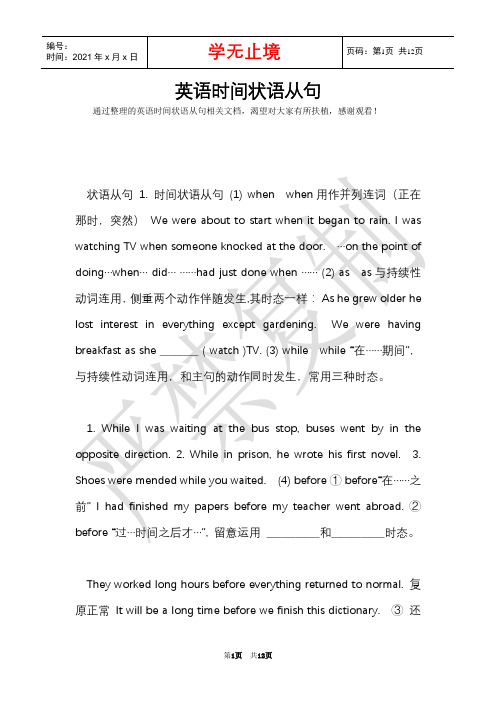
英语时间状语从句通过整理的英语时间状语从句相关文档,渴望对大家有所扶植,感谢观看!状语从句1. 时间状语从句(1) when when用作并列连词(正在那时,突然)We were about to start when it began to rain. I was watching TV when someone knocked at the door. …on the point of doing…when… did… ……had just done when …… (2) as as与持续性动词连用,侧重两个动作伴随发生,其时态一样:As he grew older he lost interest in everything except gardening. We were having breakfast as she ________ ( watch )TV. (3) while while “在……期间”,与持续性动词连用,和主句的动作同时发生,常用三种时态。
1. While I was waiting at the bus stop, buses went by in the opposite direction.2. While in prison, he wrote his first novel.3. Shoes were mended while you waited. (4) before ① before“在……之前” I had finished my papers before my teacher went abroad. ② before “过…时间之后才…”, 留意运用___________和___________时态。
They worked long hours before everything returned to normal. 复原正常It will be a long time before we finish this dictionary. ③ 还没来得及The bell rang off before I could answer it. (5) as soon as “一… 就….”,directly,immediately,instantly;the instant (that),the minute (that) ,the second (that) ,the moment (that)等通常都可与as soon as换用。
中考英语语法专题复习之九大状语从句引导词
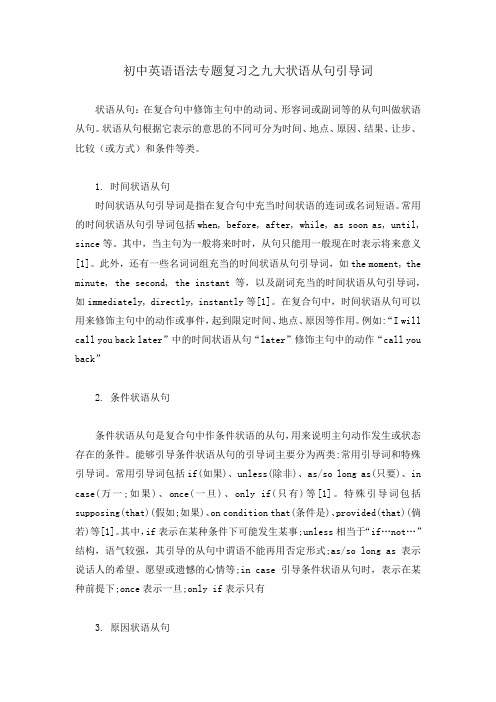
初中英语语法专题复习之九大状语从句引导词状语从句:在复合句中修饰主句中的动词、形容词或副词等的从句叫做状语从句。
状语从句根据它表示的意思的不同可分为时间、地点、原因、结果、让步、比较(或方式)和条件等类。
1. 时间状语从句时间状语从句引导词是指在复合句中充当时间状语的连词或名词短语。
常用的时间状语从句引导词包括when, before, after, while, as soon as, until, since等。
其中,当主句为一般将来时时,从句只能用一般现在时表示将来意义[1]。
此外,还有一些名词词组充当的时间状语从句引导词,如the moment, the minute, the second, the instant等,以及副词充当的时间状语从句引导词,如immediately, directly, instantly等[1]。
在复合句中,时间状语从句可以用来修饰主句中的动作或事件,起到限定时间、地点、原因等作用。
例如:“I will call you back later”中的时间状语从句“later”修饰主句中的动作“call you back”2. 条件状语从句条件状语从句是复合句中作条件状语的从句,用来说明主句动作发生或状态存在的条件。
能够引导条件状语从句的引导词主要分为两类:常用引导词和特殊引导词。
常用引导词包括if(如果)、unless(除非)、as/so long as(只要)、in case(万一;如果)、once(一旦)、only if(只有)等[1]。
特殊引导词包括supposing(that)(假如;如果)、on condition that(条件是)、provided(that)(倘若)等[1]。
其中,if表示在某种条件下可能发生某事;unless相当于“if…not…”结构,语气较强,其引导的从句中谓语不能再用否定形式;as/so long as表示说话人的希望、愿望或遗憾的心情等;in case引导条件状语从句时,表示在某种前提下;once表示一旦;only if表示只有3. 原因状语从句原因状语从句引导词通常由because, since, as, now that, not that…, but that…, seeing that, considering that, in that等引导。
- 1、下载文档前请自行甄别文档内容的完整性,平台不提供额外的编辑、内容补充、找答案等附加服务。
- 2、"仅部分预览"的文档,不可在线预览部分如存在完整性等问题,可反馈申请退款(可完整预览的文档不适用该条件!)。
- 3、如文档侵犯您的权益,请联系客服反馈,我们会尽快为您处理(人工客服工作时间:9:00-18:30)。
时间状语从句的引导词when, before, after, as, while, till/until, since,whenever时间状语从句的用法时间状语从句的引导词所表示的意思不尽相同,要注意把握不同的时间状语从句的引导词所表示的不同时间关系,以及它在具体句子中对应的对应时态、语态等问题。
1. when、as、while引导的时间状语从句分析:(1) when引导时间状语从句时表示“当……的时候”,when既可以指时间段也可指时间点,从句中既可用短暂性动词又可用延续性动词,且动作既可和主句的动作同时发生又可在主句的动作之前或之后发生。
注意体会如下例句:I’ll call you when I get there.我一到那里就给你打电话。
When the wind blows, all the doors rattle.只要风一吹,这门就吱嘎作响。
When I came home my wife was cooking dinner. 我回家时,妻子在做晚饭。
如果when引导的时间状语从句的主语与主句主语相同,而从句的谓语又是be动词时,那么从句中的主语和be 可以省略;当when引导的时间状语从句的主语与主句主语相同时,往往还可以用“when+分词”的形式替代该状语从句。
例如:When (you are) in trouble, ask her for help.当你遭遇麻烦的时候去向她求助。
When I came into the room (=When coming into the room), I found him lying there asleep.当我进入房间的时候,我发现他躺在那儿睡着了。
(2) while引导时间状语从句时表示“当……的时候”,它强调主句的动作与从句的动作同时持续地进行,用于这一用法时while引导的时间状语从句和主句中的谓语动词必须是延续性动词,或者主句的动作发生在从句动作的进行过程中,主句中的谓语动词通常是非延续性动词,例如Study while you study; play while you play.该学习的时候就学习,该玩的时候就玩。
I met her while I was at school.当我在学校的时候我遇见了她。
(3) as引导时间状语从句时表示“当……时,一边……一边……”,侧重表示两个动作同时发生(包括一个主语同时进行两个动作),或者一种动作随着另一种动作的变化而变化。
例如:He jumps as he goes along. 他边走边跳。
I slipped on the ice as I ran home.我跑回家时在冰上滑了一跤。
As the wind rose the noise increased.刮风的时候噪声增大。
[考题1] I had just steeped out of the bathroom and was busy drying myself with a towel ____ I heard the steps.A. whileB. whenC. sinceD. after[考题2] He was about halfway through his meal ____ a familiar voice came to his ears.A. whyB. whereC. whenD. while[考题3] We were swimming in the lake ____ suddenly the storm started.A. whenB. whileC. untilD. before[考题4] —I’m going to the post office.—____ you’re there, can you get me some stamps?A. AsB. WhileC. BecauseD. If[考题5] I ____ along the street looking for a place to park when the accident ____.A. went; was occurringB. went; occurredC. was going; occurredD. was going; had occurred2. before和after 引导的时间状语从句分析:before引导时间状语从句时表示主句的动作发生在从句动作之前,after引导时间状语从句时表示主句的动作发生在从句动作之后。
例如See me before you leave. 在你离开之前来见我。
Before they drive any of the buses, they will have to pass a special test.在驾驶公共汽车之前,他们必须通过专门测验。
I saw them after I arrived.在我抵达之后,我见到了他们。
I found his pen after he has left.在他走后,我找到了他的笔。
[考题6] He was told that it would be at least three more months ____ he could recover and return to work.A. whenB. beforeC. sinceD. that[考题7] It was some time ____ we realized the truth.A. whenB. untilC. sinceD. before3. till和until 引导的时间状语从句分析:till和until这两个词作连词和介词时的意义和用法相同,一般可以换用(放在句首时通常用until的形式,till在口语中更为常见)。
例如:Walk till you come to a white house.一直走到一座白房子为止。
We didn’t discuss the problem until he came back.我们一直等到他回来后才讨论问题。
[考题8] It is difficult for us to learn a lesson in life ____ we’ve actually had that lesson.A. untilB. afterC. sinceD. when[考题9] A good storyteller must be able to hold his listeners’curiosity ____ he reaches the end of the story.A. whenB. unlessC. afterD. until[答案] D[解析] 讲故事的人应该始终抓住听众的好奇心,本题应选用表示“到……为止”(跟主句里肯定形式的表延续性动作的谓语动词连用)的until 表示这一时间关系。
[考题10] I don’t really work here; I ____ until the new secretary arrives.A. just help outB. have just helped outC. am just helping outD. will just help out[答案] C[解析] “I don’t really work here”表明说话人只是临时前来帮忙,“until the new secretary arrives”表明说话人,工作到新秘书就任为止,本题应选用表示“到……为止”(跟主句里肯定形式的表延续性动作的谓语动词连用)的until表示这一时间关系。
4. since引导的时间状语从句分析:since引导的时间状语从句表示“自从……以来”,其用法主要有两种:(1) 现在完成时的主句+since引导的一般过去时态的时间状语从句。
例如:He hasn’t been home since he graduated. 他毕业后没回过家。
// They have been friends ever since they were in grade school. 他们从小学起就一直是好朋友。
// What have you been doing since I last saw you? 自我上次和你见面以后,你在做什么?(2) It be(主句中谓语用一般式和用完成式区别不大,后者更具强调意味)+表示一段时间的词汇+since引导的时间状语从句。
例如:It is two years since I became a postgraduate student. 我成为研究生已经有2年了。
It was three years since we had been there. 我们在那儿已呆了三年。
注意:since做介词时也表示“自从……以来”,其具体用法有两种情况:(1) since+表示过去某个时间点的词汇(如具体的年、月、日期、钟点)。
例如:They have been friends since childhood. 他们从幼时起一直是好朋友。
She’s been skiing since childhood. 她从幼时起就开始滑雪。
I have been there many times since the war. 自那次战争以来,我曾去该地多次。
(2) since+表示一段时间的词汇+ago。
例如:I have been here since five months ago. 五个月以来我一直在这里。
[考题11] They ____ friends since they met in Shanghai.A. have madeB. have becomeC. have beenD. have turned[答案] C[解析] 题干中的since表示“自从……以来”,主句中的谓语动词应该表示从他们在上海相遇至今的持续性的动作,因此下划线处应填入可以表示持续性状态的have been(其他选项中的made、become、turned所表示的动作都不能延续,意味着结果)。
[考题12] —What was the party like?—Wonderful. It’s been 2 years ____ I enjoyed myself so much.A. afterB. beforeC. whenD. since[答案] D[解析] since表示“自从……以来”。
①.when"当......时候"引导的时间状语从句,其动词既可以是延续性动作的动词,也可以是瞬间性动作的动词,如:_________ the students heard the teacher's footsteps, they all stopped talking.当学生们听到老师的脚步声时,他们都停止了讲话。
